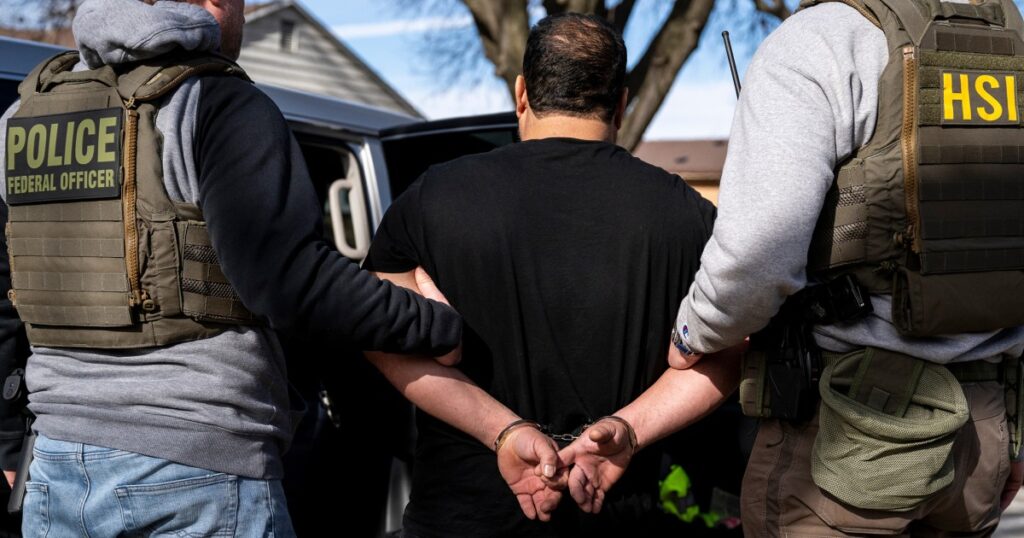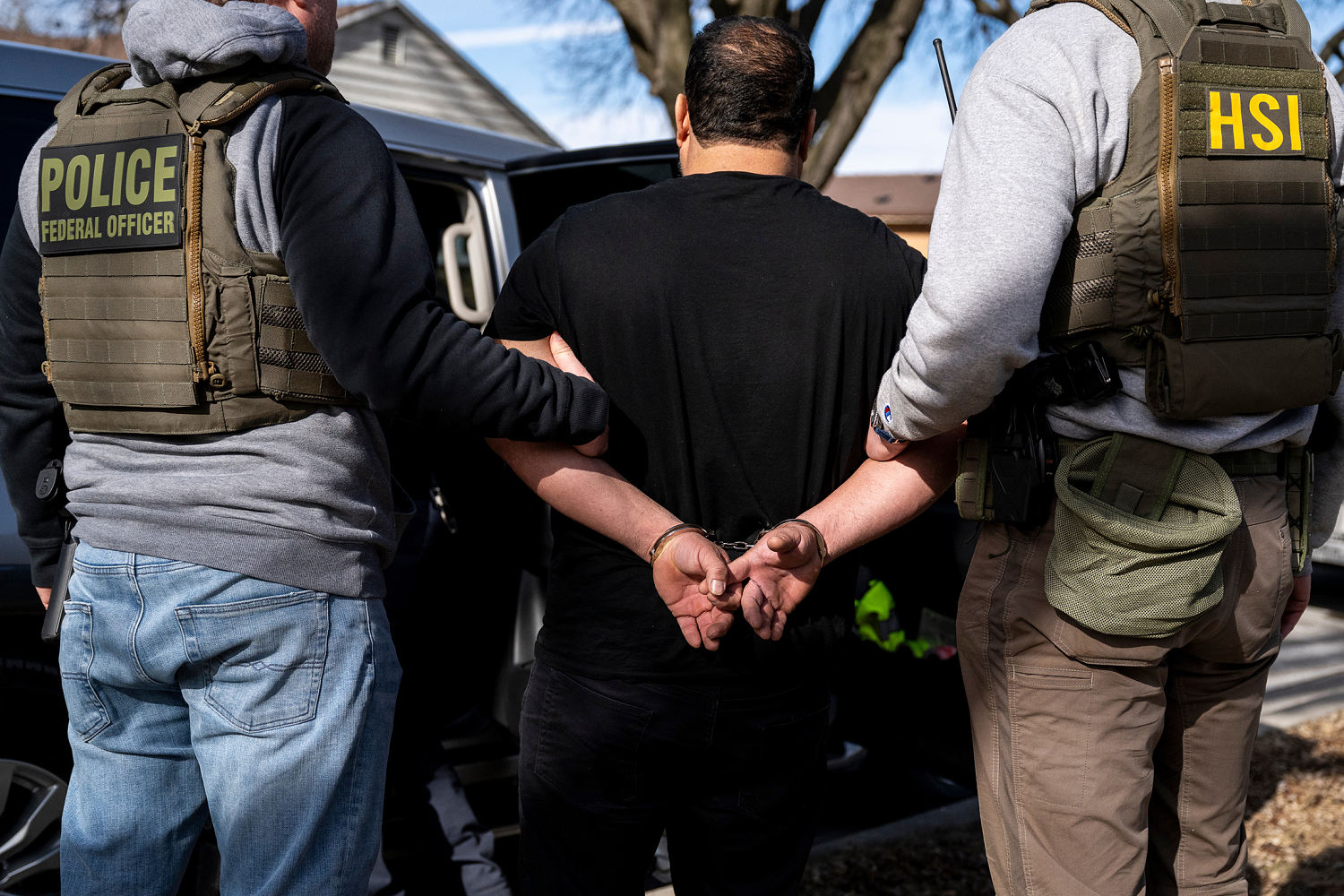

As arrests of immigrants increase, the administration is scrambling to make sure it has the room to house its detainees and keep President Donald Trump’s promise to deport them.
Trump’s “border czar,” Tom Homan, told NBC News that Immigration and Customs Enforcement needs 100,000 beds total, more than double what it has currently. Trump alluded to the need for more room when he ordered the Pentagon and the Department of Homeland Security on Wednesday to prepare 30,000 beds at Guantánamo Bay for who he said would be detainees posing the greatest threat to Americans’ safety.
An immigration detention room is used to hold people until they are deported, and it “is really kind of a backbone of the mass deportation plan,” said Jesse Franzblau, a senior policy analyst with the National Immigrant Justice Center.
“That’s why we see [ICE] floating numbers. They talk about doubling the space to hold people in these ICE jails,” Franzblau said.
The Biden administration made an average of 282 immigration arrests per day in September 2024, the most recent ICE data available.
So far, using seven days of data, the Trump administration’s daily average is 791.
Homan said his instructions to officers and agents were “arrest as many as you can.”
The Trump administration launched its mass deportations operation despite ICE’s $230 million budget shortfall. The first bill Trump signed this term, the Laken Riley Act, requires ICE to detain undocumented immigrants who are arrested or face charges or who have been convicted of “burglary, theft, larceny, or shoplifting.” But it didn’t include new money to detain those additional immigrants, which DHS said in December it would need.
As of January, ICE reported it had at least 106 facilities nationwide. Congress appropriated funding to detain an average of 41,500 people a day, at a cost of about $3.4 billion.
That was an increase over fiscal year 2023, when Congress provided funding to detain a daily average of 34,000 people, costing about $2.9 billion. The House is in the midst of trying to hammer out a budget bill that would include money for Trump and his immigration crackdown; congressional Republicans have put the price tag at about $100 billion.
The cost of each ICE detention bed is $57,378 per year, per bed, according to DHS data.
Daily detention numbers reached a height of 50,000 average daily population under the first Trump administration, but fell to about 20,000 when Covid hit.
A vast network
The thousands of immigrants taken into custody each year are often locked up in a vast network of facilities, some owned by the federal government and state or local governments but most contracted from private entities.
The American Civil Liberties Union discovered through open government requests that the Biden administration was seeking to expand detention space nationwide.
The Trump administration has already begun to supplement the space it’s using.
DHS is using facilities at Buckley Space Force Base in Aurora, Colorado, for processing immigrants with criminal charges or convictions who were arrested in ICE operations in the state. The military made the space available, possibly to be used for a previously planned operation in Aurora.
The Trump administration has instructed the Justice Department to investigate for potential prosecution state or local officials who resist enforcement of federal immigration laws.
Some states, such as Illinois, have limited or ended immigration detention. New Jersey banned the building of new immigration detention centers, though private companies have sued to block that law. But other local and state governments have long had contracts with ICE for detention space.
Sheriff Scott Hildenbrand in Geauga County, Ohio, said his department has had a contract for 15 to 20 years with ICE to hold immigrant detainees. Hildenbrand said ICE brought in 20 people who’d been arrested over the weekend, raising the detainee population to 58, but since then, ICE removed six people from the jail.
He said as far as he knew, none of those brought in were wanted on local warrants.
“They called us and asked ‘Do you have room for 20?’ and brought them in,” Hildenbrand told NBC News.
Hildenbrand said the immigrant population in the jail has generally been steady.
He said his facility has 182 beds and typically can take in as many as 60 to 70 immigrants, depending on how many other people are in the jail who are not ICE detainees. The county is paid $100 a day for each detainee.
The immigration detention system has been a continuous target of criticism from immigrant advocates and government watchdogs over conditions including lack of access to attorneys and substandard medical care as well as issues of cost and effectiveness.
The section of the Guantánamo Bay detention facility that Trump wants to use has been housing adults and families with young children interdicted at sea as they’ve tried to flee to the U.S. It is separate from the military prison where the U.S. placed detainees after the Sept. 11, 2001, terrorist attacks.
The refugee families detained there have included people and children from Cuba who have tried to escape the Cuban government, according to the International Refugee Assistance Project, IRAP, which documented in a report the conditions and some of the experiences of adults and children held there.
In its report, IRAP said former clients, detained refugees and former staff described the building where they were incarcerated as dilapidated with mold and sewage problems. They reported that families with young children were housed with single adults. Those held are unable to have confidential phone calls with attorneys and are punished if they discuss being mistreated.
Many who are kept in the Guantánamo Bay facility must remain there until a third country agrees to accept them — even if they have family in the U.S. — and are kept for years, the report states. Some countries such as Cuba and Venezuela don’t accept the return of their citizens deported from the U.S.
“We have report on report on conditions in these detention facilities that don’t provide basic health care, shackle women when pregnant, have not had protections for communicable diseases such as Covid,” said Raha Wala, a vice president of the National Immigration Law Center.
“We saw a movement to Guantánamo,” Wala said about Trump’s directive, “which is the legal equivalent of a black hole.”
 Latest World Breaking News Online News Portal
Latest World Breaking News Online News Portal






